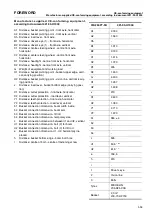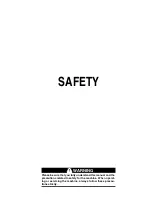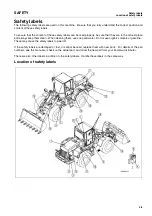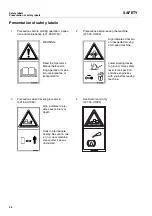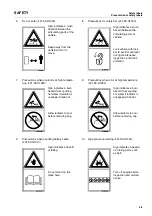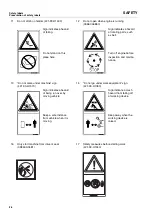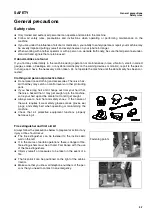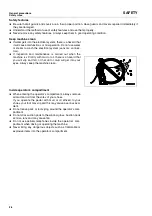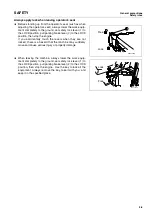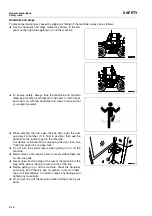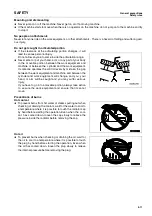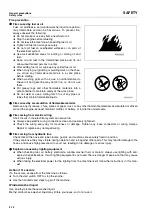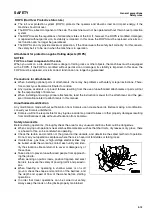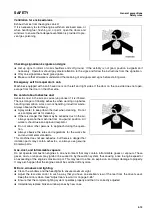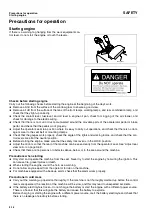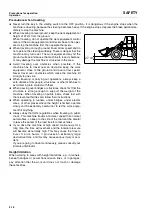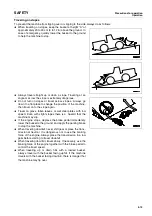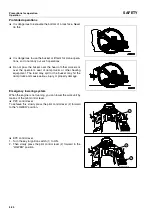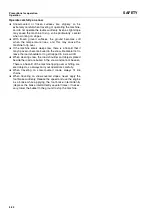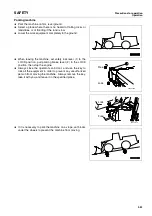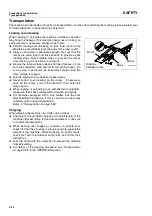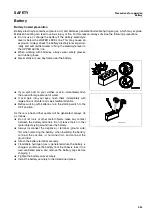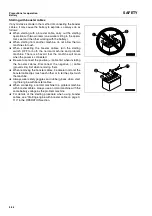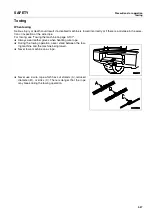
SAFETY
General precautions
Safety rules
2-13
ROPS (Roll Over Protective Structure)
0.
The roll-over protection system (ROPS) protects the operator and absorbs load and impact energy, if the
machine should roll over.
The ROPS is a fixed component of the cab. The machine must not be operated without this roll-over protection
system.
The ROPS meets the regulations of all member states of the EU. If, however, the ROPS is modified, damaged,
or repaired without permission, its stability is impaired. In this case, the ROPS must be replaced, since its cor-
rect function can no longer be guaranteed.
The ROPS can only provide maximum protection, if the driver wears the safety belt correctly. For this reason,
the safety belt is to be worn when the machine is in operation.
Attachment for protection against falling objects (FOPS)
0.
NOTICE
FOPS is a fixed component of the cab.
When you work on a site where there is danger of falling rocks or other objects, the machines must be equipped
with a FOPS. If the FOPS is modified without permission or damaged, its stability is impaired. In this case, the
FOPS must be replaced, since its correct function can no longer be guaranteed.
Precautions for attachments
0.
When installing optional parts or attachments, there may be problems with safety or legal restrictions. There-
fore contact your Komatsu distributor for advice.
Any injuries, accidents, or product failures resulting from the use of unauthorized attachments or parts will not
be the responsibility of Komatsu.
When installing and using optional attachments, read the instruction manual for the attachment, and the gen-
eral information related to attachments in this manual.
Unauthorized modification
0.
Any modification made without authorization from Komatsu can create hazards. Before making a modification,
consult your Komatsu distributor.
Komatsu will not be responsible for any injuries, accidents, product failures or other property damages resulting
from modifications made without authorization from Komatsu.
Safety at worksite
0.
Before starting operations, thoroughly check the area for any unusual conditions that could be dangerous.
When carrying out operations near combustible materials such as thatched roofs, dry leaves or dry grass, there
is a hazard of fire, so be careful when operating.
Check the terrain and condition of the ground at the worksite, and determine the safest method of operation.
Do not carry out operations at places where there is a hazard of landslides or falling rocks.
If water lines, gas lines, or high-voltage electrical lines may
be buried under the worksite, contact each utility and iden-
tify their locations. Be careful not to sever or damage any of
these lines.
Take action to prevent unauthorized people from approach-
ing the jobsite.
When working on public roads, position flagmen and erect
barriers to ensure the safety of passing traffic and pedestri-
ans.
When traveling or operating in shallow water or on soft
ground, check the shape and condition of the bedrock, and
the depth and speed of flow of the water before starting
operations.
In order that travel operations can be carried out safely,
always keep the roads on the jobsite properly maintained.
Summary of Contents for WA250PT-5H
Page 2: ......
Page 3: ...FOREWORD 11...
Page 16: ...Contents FOREWORD 1 14...
Page 24: ...SAFETY 2 2...
Page 58: ...Precautions with tires SAFETY Precautions when storing tires 2 36...
Page 60: ...OPERATION 3 2...
Page 233: ...TECHNICAL DATA 45...
Page 235: ...TECHNICAL DATA Technical data 5 3...
Page 250: ...Central lubrication system ATTACHMENTS OPTIONS 6 14...
Page 251: ...INDEX 67...
Page 252: ...INDEX 7 2...
Page 255: ...Index 7 5...

